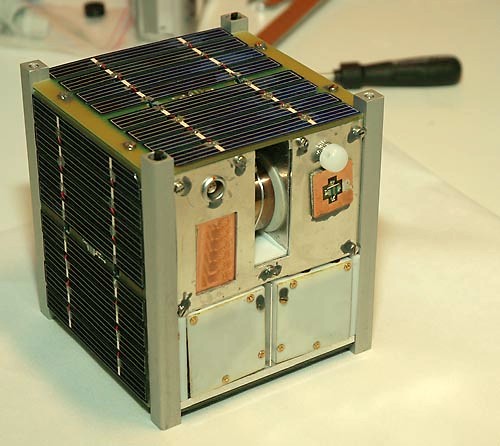Cubesats what are they
Cubesat are actualy a realy small setelites . according to Wikipedia: "A CubeSat is a class of miniaturized satellite based around a form factor consisting of 10 cm (3.9 in) cubes.[1] CubeSats have a mass of no more than 2 kg (4.4 lb) per unit, and often use commercial off-the-shelf (COTS) components for their electronics and structure. CubeSats are put into orbit by deployers on the International Space Station, or launched as secondary payloads on a launch vehicle. As of August 2021, more than 1,600 CubeSats have been launched. In 1999, California Polytechnic State University (Cal Poly) professor Jordi Puig-Suari and Bob Twiggs, a professor at Stanford University Space Systems Development Laboratory, developed the CubeSat specifications to promote and develop the skills necessary for the design, manufacture, and testing of small satellites intended for low Earth orbit (LEO) that perform a number of scientific research functions and explore new space technologies. Academia accounted for the majority of CubeSat launches until 2013, when more than half of launches were for non-academic purposes, and by 2014 most newly deployed CubeSats were for commercial or amateur projects.Uses typically involve experiments that can be miniaturized or serve purposes such as Earth observation or amateur radio. CubeSats are employed to demonstrate spacecraft technologies intended for small satellites or that present questionable feasibility and are unlikely to justify the cost of a larger satellite. Scientific experiments with unproven underlying theory may also find themselves aboard CubeSats because their low cost can justify higher risks. Biological research payloads have been flown on several missions, with more planned. Several missions to the Moon and beyond are planning to use CubeSats. The first CubeSats in deep space were flown in the MarCO mission, where two CubeSats were launched towards Mars in May 2018 alongside the successful InSight mission. Some CubeSats have become countries' first-ever satellites, being launched by universities, state-owned, or private companies. The searchable Nanosatellite and CubeSat Database lists over 3,200 CubeSats that have been and are planned to be launched since 1998"

So those are pretty lightweight vehicles compared to the James Webb space telescope which is about 6200 kg. With that, it is also much cheaper to launch and build for space. That cheap there are crowd-sourced CubeSat missions based around off the self component like arduinos.
But because they are small and cheap they can do a lot of useful work. For example, NASA uses it right now to test a new elliptical lunar orbit for a later deep space mission for Artemis this spacecraft is called CAPSTONE this is a 12 u sized CubeSat weight approximately 25 kg.

Cubesats are great. They are small, cheap, and could do as much in most cases as a normal-sized CubeSat. And in the future maybe we could use them to build larger things like a big spacecraft.
Tessellated Electromagnetic Space Structures for the Exploration of Reconfigurable, Adaptive Environments. Each TESSERAE structure is made from a set of tiles. These tiles are tuned to autonomously self-assemble into a particular geometry—in our initial prototypes, we have focused on buckminsterfullerene (20 hexagonal tiles, 12 pentagonal tiles). Each tile at a minimum includes a rigid outer shell, responsive sensing, and control code for bonding diagnosis, electro-permanent magnets for dynamically controllable bonding actuation, and an on-board power harvesting and power management system. Habitat-scale TESSERAE tiles will also include clamping and sealing for pressurization. Tiles are released in microgravity testing environments to quasi-stochastically self-assemble.
![]()
Cubesat has a great future NASA planning to use one to monitor climate change . They are also a big business according to alliedmarketresearch.com: "The growing usage of CubeSats has laid the foundation for increased deployment of the Internet of Things (IoT) on a worldwide scale, enabling the interconnection of areas of the Earth without ground communication through the setups in space. The world is witnessing an increasing number of sensor-driven devices that require global communications and connections.
The detection and monitoring of assets such as ships, aircraft, and vehicles among others, can be quite unmanageable in places devoid of land cover. CubeSat constellations, located in space and providing access to images across the globe, can give access to real-time information of various assets anywhere on the Earth. CubeSats can aid the present network technologies by offering intricate logistics administration solutions. "

So CubeSats have a great future and also who like machines space and things like CubeSats has a great and interesting future.
